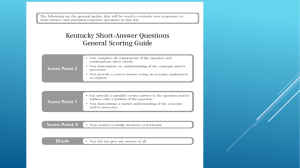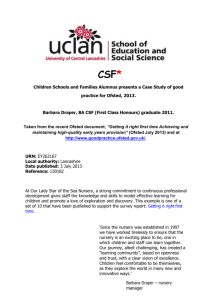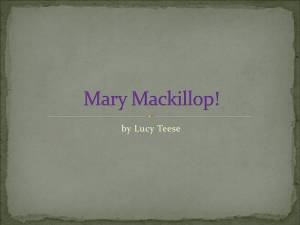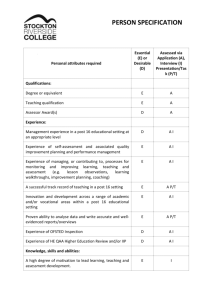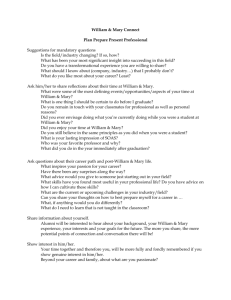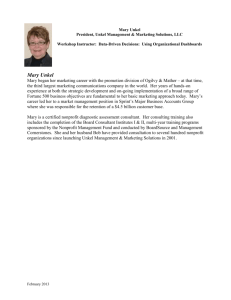St Mary`s Church of England Voluntary Controlled Primary
advertisement
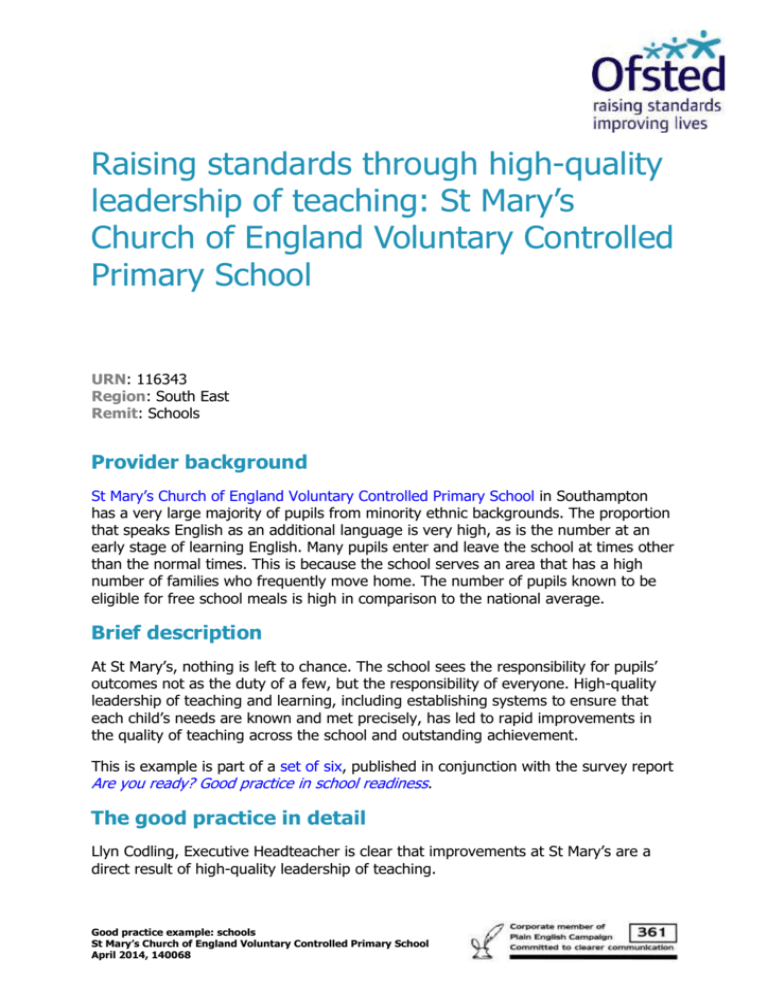
Raising standards through high-quality leadership of teaching: St Mary’s Church of England Voluntary Controlled Primary School URN: 116343 Region: South East Remit: Schools Provider background St Mary’s Church of England Voluntary Controlled Primary School in Southampton has a very large majority of pupils from minority ethnic backgrounds. The proportion that speaks English as an additional language is very high, as is the number at an early stage of learning English. Many pupils enter and leave the school at times other than the normal times. This is because the school serves an area that has a high number of families who frequently move home. The number of pupils known to be eligible for free school meals is high in comparison to the national average. Brief description At St Mary’s, nothing is left to chance. The school sees the responsibility for pupils’ outcomes not as the duty of a few, but the responsibility of everyone. High-quality leadership of teaching and learning, including establishing systems to ensure that each child’s needs are known and met precisely, has led to rapid improvements in the quality of teaching across the school and outstanding achievement. This is example is part of a set of six, published in conjunction with the survey report Are you ready? Good practice in school readiness. The good practice in detail Llyn Codling, Executive Headteacher is clear that improvements at St Mary’s are a direct result of high-quality leadership of teaching. Good practice example: schools St Mary’s Church of England Voluntary Controlled Primary School April 2014, 140068 Three key strands make up the school’s work in this area: rigorous monitoring of both children’s achievements and the quality of teaching a developmental coaching programme personalised programmes and transition plans for individual children. Rigorous monitoring The school sees high-quality induction and transition arrangements as paramount. It has a clear rationale and an in-depth set of processes for managing children’s various transitions throughout the school. Children joining the nursery or reception classes have a comprehensive induction programme. Significant information is gathered at initial home visits by school staff about each child’s: family circumstances two-year-old health checks academic, social and emotional well-being. This information is used to plan carefully for children’s initial induction and subsequent experiences in nursery or reception. This level of detail and precision at the start of a child’s journey sets the tone for their ongoing experiences at the school. From the beginning, regular checks are made to ensure all children are doing as well as they possibly can: Detailed evaluations of learning journals, lesson observations and a range of data are shared within, and beyond the school. Six-weekly review meetings to check children’s progress are used exceptionally well to re-shape learning experiences. Moderation is thorough and takes place internally across Early Years and into Year 1 as well as through the local Teaching School Alliance, including other early years settings. Leaders at all levels contribute significantly to the procedures to check how well children are doing. Teachers use new technologies, including tablet computers and digital photography, well to capture and check on children’s achievements in lessons. Photos are annotated then linked to the school’s very detailed tracking system that covers all areas of learning. The system is accessible to and used by governors to ask challenging questions and plan priorities for improvement. 2 Good practice example: schools St Mary’s Church of England Voluntary Controlled Primary School April 2014, 140068 The entire tracking approach is complemented by monitoring of the quality of teaching. Performance management procedures are rigorous and very well organised, as inspectors found at the school’s most recent inspection. Transition is smooth because there is a consistency of teaching and learning strategies from the Early Years Foundation Stage throughout the school. Close liaison and effective information sharing between phase leaders ensures that all staff are aware of children’s strengths and next steps in their learning. Coaching for improvement Senior leaders are clear in their rationale for developmental coaching. Professional development feedback is instrumental to improving the quality of teaching at the school. A key element of this is the use of ‘Parrot on the shoulder’ coaching, where teachers receive direct in-class support that provides real-time feedback on their teaching. This has led to rapid improvements and up-to-date and innovative practice is shared, refined and developed. Working within the Teaching School Alliance provides additional opportunities for moderation, training and specialist teacher development. Senior and middle leaders work alongside early years colleagues to check lessons, children’s work and lesson planning. Consequently, staff are eager to learn from each other and act upon coaching guidance ‘in association with collegial enquiry, critical thinking and expanding teaching repertoires’1. The school believes it is imperative that teachers are given verbal and written feedback with targets to work on to raise the quality of day-to-day teaching in the class. Teachers welcome the coaching in this supportive way through a non-threatening environment. As one said: ‘At other schools, I have been told what my weaknesses Blasé, and Blasé, Handbook of instructional leadership: How effective principals promote teaching and learning; Corwin Press, 1998. 1 Good practice example: schools St Mary’s Church of England Voluntary Controlled Primary School April 2014, 140068 3 are, but here they are dealt with and I am supported brilliantly. This has resulted in my being a much better teacher.’ Individual programmes Prior to starting in the nursery, high-quality information about the school is provided for all parents and carers. The use of pictures, graphs and diagrams makes this information easily accessible to parents and carers who may have low levels of literacy or English as an additional language. The information provided is personal to each child, including photos of the members of staff they will be working with and familiar places within the nursery. Visits to the nursery and ‘The Nest’ (a provision for those who are identified as needing specific early intervention or nurture) help to start to build confidence early on. In order to get to know children as quickly as possible, the school undertakes a case study approach for individual children. These provide highly detailed narratives and in-depth insight into the achievements of each child right from the start and are used to pass on detailed information to the next teacher. Evaluations by parents and carers on the effectiveness of transition arrangements are used to re-shape programmes. Due to their high degree of involvement in training sessions such as ‘Books before breakfast’, contribution to individual education plans if their child has special educational needs and parental workshops, trust between the school and families is established quickly. Other good practice examples in this set Ann Tayler Children’s Centre Nursery Little Stars Childcare Centre Mayflower Primary School St Mary’s Church of England Voluntary Controlled Primary School Stanton Bridge Primary School The Village Nursery 4 Good practice example: schools St Mary’s Church of England Voluntary Controlled Primary School April 2014, 140068 The good practice case studies that Ofsted publishes highlight specific examples of practice that providers of education, learning and children’s services have used to achieve successful outcomes. For education, the case studies do not recommend a single particular approach to teaching and learning. Ofsted has no preferred lesson structure or teaching style. We showcase and share a wide range of approaches that providers have found work well for them in achieving good outcomes for children, young people and learners. Are you thinking of putting these ideas into practice; or already doing something similar that could help other providers; or just interested? We'd welcome your views and ideas. Get in touch here. To view other good practice examples, go to: www.ofsted.gov.uk/resources/goodpractice. If you would like a copy of this document in a different format, such as large print or Braille, please telephone 0300 123 1231, or email enquiries@ofsted.gov.uk. Good practice example: schools St Mary’s Church of England Voluntary Controlled Primary School April 2014, 140068 5
